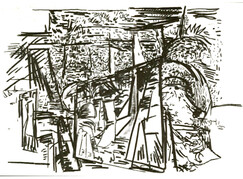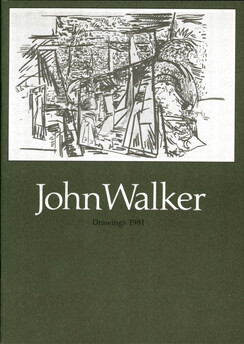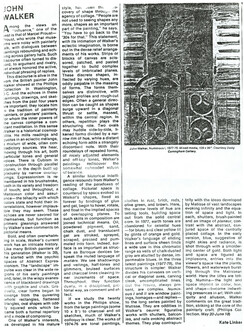This exhibition is now closed
John Walker Drawings
11 July –
16 August 1981

John Walker born in Birmingham in 1939 is recognised as one of Britain's leading contemporary painters. Considered one of the most Transatlantic painters, with Hockney, Alloway and Richard Smith, he regularly commutes between England and the United States, has taught widely in both countries and won a number of prestigious awards in recognition of his stature among painters of his generation.
The position Walker has adopted in his work is at the core of what is happening to American painting in the eighties. Instead of the drive towards reductivism and innovation which has been the tendency over the last twenty years, artists are now actively demonstrating their commitment to painting as a major art and are focusing on universal concepts than narrowing their vision to the local or topical. Further more there appears to be a re-establishment of dialogue with past masters. Walker has always readily allowed the precedent of particular artists and paintings to play a part in the evolution of his own highly individual imagery. Subsequently he has referred closely to Velasquez, Manet, Matisse, Goya and Picasso.
Walker's drawings assembled by Anne Kirker, curator of prints and drawings at the National Art Gallery, Wellington for this New Zealand tour present a rare opportunity to trace the evolutionary process of two major themes.
The first of the twenty four exhibits – the earliest work being December 1980, are the first tentative explorations into the meaning of a large canvas. 'A Moroccan', Adventurous and complex, this incorporates the central motif, an irregular polygonal form in a variety of compelling and mysterious situations. In one instance short and swift charcoal strokes present a crisp surface structure while in others, a translucent wash pushes the drawing out from impressionism towards a more personal and subjective world.
The second group of exhibits relates to the series of horizontal paintings known as 'Labyrinth', which takes its compositional order from Velasquez's 'Las Meninas', not necessarily echoing the original figures, dogs and studio paraphernalia. Instead they take hybrid forms which have their own dynamic form.
The drawings in this exhibition derived their origin not as preparatory drawings for paintings but as studies from either completed canvases or particular stages in their development. The painting itself was the 'Motif'. Walker explains, "This has been my practice for some time, not to sit merely looking at the picture in its finished state, but to try and visualise what I see . . . to draw accurately what I believe to be there. In other words, everything that is the main thrust of the drawing I have seen in the painting. I have often concluded that the drawing has become the conclusive statement, not the painting'.
('John Walker Drawings', Bulletin, No.16, July/August 1981, p.3)
Exhibition number: 263



